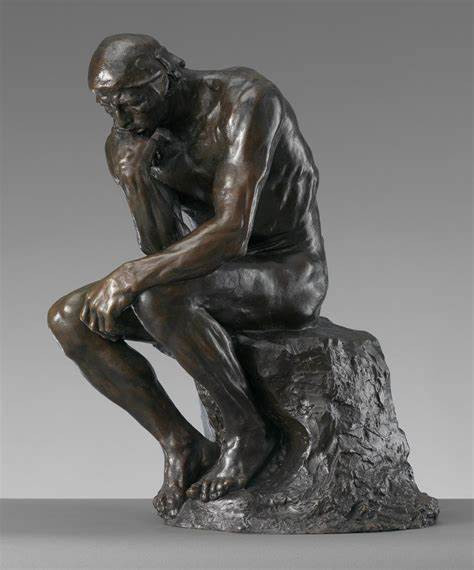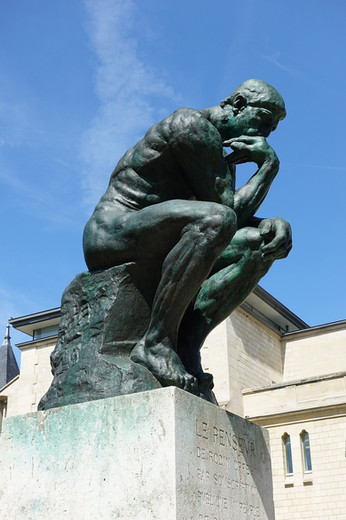HOME | DD
 AgyGuru — History of art the 12th of November
AgyGuru — History of art the 12th of November

#jung #thinker #historyofart #rodiin
Published: 2022-11-12 14:41:45 +0000 UTC; Views: 3580; Favourites: 32; Downloads: 1
Redirect to original
Description
François Auguste René Rodin (12 November 1840–17 November 1917) was a French sculptor, generally considered the founder of modern sculpture. He was schooled traditionally and took a craftsman-like approach to his work. Rodin possessed a unique ability to model a complex, turbulent, and deeply pocketed surface in clay. He is known for such sculptures as The Thinker, Monument to Balzac, The Kiss, The Burghers of Calais, and The Gates of Hell.
He modeled the human body with naturalism, and his sculptures celebrate individual character and physicality. Although Rodin was sensitive to the controversy surrounding his work, he refused to change his style, and his continued output brought increasing favour from the government and the artistic community.
Many of Rodin’s most notable sculptures were criticized, as they clashed with predominant figurative sculpture traditions in which works were decorative, formulaic, or highly thematic. Rodin’s most original work departed from traditional themes of mythology and allegory.
An allegory is a narrative or visual representation in which a character, place, or event can be interpreted to represent a hidden meaning with moral or political significance. Authors have used allegory throughout history in all forms of art to illustrate or convey complex ideas and concepts in ways that are comprehensible or striking to its viewers, readers, or listeners.Among the best-known examples of allegory, Plato’s Allegory of the Cave, forms a part of his larger work The Republic.
Writers and speakers typically use allegories to convey (semi-) hidden or complex meanings through symbolic figures, actions, imagery, or events, which together create the moral, spiritual, or political meaning the author wishes to convey. Many allegories use personification of abstract concepts.
The cover picture is the Thinker. Initially entitled Dante or Poète, Le Penseur — one of Rodin’s best known works, — was sculpted by the artist between 1880 and 1882 for the tympanum of the celebrated Gates of Hell. The entrance to the Musée des Arts Décoratifs in Paris was intended to feature a series of figures drawn from Dante’s epic poem, sculpted in bas relief. In 1888 a smaller version of the sculpture was exhibited in Copenhagen, and in 1902 a monumental version was cast, two and a half metres tall. It was displayed two years later at the 1904 Salon, and then installed in front of the Panthéon, before being moved to the Musée Rodin.
Over time the work, which shows clear signs of Michelangelo’s influence, has lost its link with its original destination and has been transformed into a symbol of intellectual and creative activity.
Before reflecting and making my own opinion about the Thinker I wanted to find out how Rodin described his own opera.
He said “ What makes my thinker think is that he thinks not only with his brain, with his frown, with his distended nostrils and compressed lips, with every muscle in his arms, back and legs, with his clenched fist and (tensed) toes”
Also I found information with regards to how this opera was praised by critics. Some commentators mention that the Thinker occupies in Hell’s Gate a position similar to that of the sacred figures in Gothic portals; therefore, he is a judge and at the same time a prisoner in hell. It is a projection of the sculptor, of the artist in general, who confronts the critics of his time and those he also judges.
In 1904, Gabriel Mourey, editor of the magazine Les Arts de la Vie, showed the statue in an exposition at Paris and the fame of the Thinker spread from a minority interested in aesthetic questions to the international public.
Mourey explained with the following words why the Thinker had been selected: “We chose this magnificent work over all the others because he is no longer the poet suspended over the gulfs of sin and atonement, crushed by pity and the terror of the inflexibility of a dogma, he is no longer the exceptional being, the hero; he is our brother in suffering, in curiosity, in thought, in joy, the bitter joy of seeing and knowing; he is no longer a super human, a predestined, he is simply a man of all time.”
Art analysis of the Thinker
I will start with a reflection on the way Rodin described this statue: it seems that we need to see the Thinker thinking with all his body. This statement can be interpreted in many ways, as follows:
I can look at the suggested full body awareness as a sort of mindfulness. In psychology mindfulness is the ability to maintain a moment-by-moment awareness of our thoughts, feelings, bodily sensations, and surrounding environment. To live mindfully is to live in the moment, rather than ruminating on the past or worrying about the future.
Mindfulness is rooted in Buddhist and Hindu teachings. Individuals who practice Zen meditation attempt to expand their attentional scope to incorporate the flow of perceptions, thoughts, emotions, and subjective awareness.
I also see the tension in the Thinker’s body as the ability to live our life with passion, being fully engaged in the present, with the totality of our being. Rodin might have wanted to deliver us the message to “seize the day”, encouraging us to focus on the present, appreciate the value of every moment in life, and avoid postponing things unnecessarily, because every life eventually comes to an end.
To understand the way Gabriel Mourey sees the Thinker we need to break down his statement in smaller chunks.
I will start making comments by using his conclusion that the Thinker “is simply a man of all time”, which suggests that he is an archetypal figure of our human condition. And what is the most archetypal activity in which we engage? It is thinking, we all are thinkers, (or at least we should be).
The statement that the Thinker is “our brother in suffering, in curiosity, in thought, in joy” is the very description of our human condition. In the context it suggests also the source of our most intimate inner life springs from our thoughts. Thinking is pondering over what makes us unhappy or happy; how we can attain knowledge about ourselves or the world with the help of curiosity, and also what can bring us joy.
Whereas critics and the artist are major sources of information on how to interpret the opera, it is important to rely on our own feelings.
I can remember the first reaction I had when I saw the Thinker in a picture and I am going to share it with you in my final reflection on this topic. I felt that Rodin uses his aert to make us ask ourselves existential questions like: What’s the meaning of life? What’s the most important value of our life? Does God exist?
With regards to the meaning and purpose of life I am not going too far or too deep during this reflection because many future articles will tackle this problem in the context of the existential intelligence.
The famous psychologist Maslow posited that the purpose of life is self actualization. In Jungian psychology individuation has many similarities with the process of self actualization. In Carl Jung’s work, he suggested that individuation was a self-realization process. Throughout life, people are prone to losing touch with certain aspects of their true selves. Through individuation, they are able to integrate these aspects of themselves with all of their new learning and experiences that they gain throughout life.
The most important value is life is a matter of culture and personal choices. In a consumerist and materialistic culture the extrinsic values such as money, goods, authority, and status are considered the most important values. I do not subscribe to this because I am more spiritual oriented and I feel that eudaimonic values like virtues and excellence are more important in our lives than our possessions. Also I feel that love is the supreme value. In psychology I can see some parallels between love and social intelligence, having many aspects of behaviours in common like compassion, empathy, benevolence, gratitude, ethics, and altruism.
With regards to God, again there is a matter of culture and personal beliefs. I believe in Logos as a principle that organizes our life. I agree with Parmenides, an ancient Greek philosopher who posited that nothing can come from nothing. Also I believe that God is love and that love is the most important contributor to our wellbeing.
I can carry on and on, like the Thinker, but at times we need to take a break and not overanalyze everything. I leave at this stage deep thinking to the Thinker, after all this is the purpose that was given to him by his creator.
Related content
Comments: 3

👍: 0 ⏩: 0

👍: 0 ⏩: 1

👍: 1 ⏩: 0

























